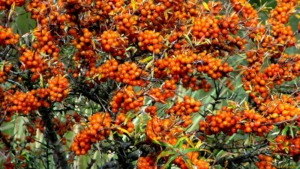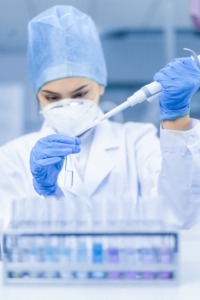We comprehensively analyze the effect of sea buckthorn (Hippophaes rhamnoides) on glucose homeostasis on central regulatory steps of postprandial glucose metabolism. Various biological models were utilized as complementary systems, including human cell lines, non‐vertebrate organisms, and the chick embryo model.
Sea buckthorn is a rich source of biologically active compounds that benefit human health. In particular, sea buckthorn oil contains ∼190 compounds with putative biological activity. HLPC‐MS analyses, in combination with biological assays, revealed that isorhamnetin is highly abundant in all sea buckthorn products tested and is one of the biologically active compounds triggering GLUT4 cell surface localization.
This finding is consistent with previous reports, which showed that isorhamnetin promotes glucose uptake in myotubes. Noteworthy, the effect of sea buckthorn products on GLUT4 translocation exceeded the effects observed after treatment with isolated isorhamnetin. This suggests the presence of additional biologically active compounds that synergize with isorhamnetin. Indeed, abundant in sea buckthorn leaves, gallic acid induces GLUT4 cell surface localization.
As we observed no effects of sea buckthorn oils and extracts on glucose absorption and no effect on insulin secretion, we hypothesize that the main glucose‐lowering property of sea buckthorn is increased insulin‐mediated glucose clearance by muscle and adipose tissue. It is consistent with the fact that sea buckthorn lowered glucose levels in the chick embryo model. The advantage of this model system is its sensibility to insulin, while no endogenous insulin is detected until day 12 of development.
Therefore, using the chick embryo model on day 11 enables the direct examination of glucose clearance from the circulation without interfering with endogenous insulin production. A putative limitation of this model system is the lack of a GLUT4 homolog, suggesting that another insulin‐responsive glucose uptake mechanism is present in the chick embryo.
In overweight human subjects, consuming a sea buckthorn‐rich meal decreased and delayed insulin response. The authors attribute this effect to improved insulin sensitivity, allowing reduced insulin production. It suggests that sea buckthorn products can increase glucose clearance from the bloodstream into muscle and adipose tissue, reducing insulin production and pancreatic β-cell protection.
A further finding of our study is that sea buckthorn can revert hyperglycemia in the nematode C. elegans. Glucose concentrations resembling the hyperglycemic conditions in diabetic patients can be easily achieved in C. elegans. Comparable to humans, C. elegans can store excess glucose as glycogen or fatty acids after de novo lipogenesis. In addition, C. elegans can store excess glucose as the trisaccharide trehalose. Notably, the insulin signaling pathway is a conserved regulator of glucose storage across species, including humans and nematodes. In particular, daf‐2, an insulin receptor‐like gene, controls lipid and carbohydrate storage in C. elegans.
Therefore, we hypothesize that sea buckthorn’s observed anti-hyperglycemic effect is due to increased cellular uptake followed by conversion and storage as glycogen, trehalose, or triglycerides. Of note, sea buckthorn products counteracted hyperglycemia but did not lower glucose levels under basal conditions. A potential limitation of using C. elegans is differential regulation of FTG‐1, the only identified GLUT homolog in the nematode. Even though FTG‐1‐mediated glucose uptake is regulated by insulin signaling, its function is controlled by glycosylation rather than by translocation, as is the case for GLUT4.
While sea buckthorn products effectively ameliorated hyperglycemia in C. elegans, neither sea buckthorn oil nor extracts lowered systemic glucose levels in D. melanogaster. Drosophila expresses several functional insulin‐like peptides. While a GLUT4 homolog remains to be identified, insulin was shown to increase the function of transgenic GLUT4 in drosophila fat cells, indicating conserved glucose uptake processes.
Noteworthy, these experiments were conducted under standard euglycemic conditions based on feed containing 10% starch, a putative limitation. This is because trehalose, but not glucose, is the main carbohydrate in drosophila’s circulation under euglycemic conditions. Indeed, in previous studies, a high carbohydrate diet containing a sucrose concentration of 1 mol L−1 (equivalent to ∼34% sucrose) was used to induce insulin resistance in drosophila.
Besides studying the physiological effects of sea buckthorn products, this study aimed to compare various sea buckthorn products and plant parts regarding their bioactive compounds and biological effects. Harvesting sea buckthorn berries is laborious and is often accomplished by removing complete branches followed by separating the berries. Therefore, considerable amounts of by‐products, including leaves, emerge. Similarly, press cakes originate from oil production, typically not further utilized.
Therefore, using different plant parts and remnants of sea buckthorn for the subsequent production of dietary supplements is a sustainable approach. While the other matrices of oils and aqueous extracts impeded direct comparison in some of the analyses performed, the presence of isorhamnetin was confirmed in all sea buckthorn products tested. Furthermore, biological effects were broadly comparable throughout the biological assays performed. Therefore, sea buckthorn products that beneficially affect human health are not necessarily restricted to the use of oils and fruits.
Taken together, we have identified sea buckthorn oils, fruits, leaves, and press cake as promising raw materials for the generation of nutrient supplements to counteract dysregulated glucose metabolism by increasing insulin‐dependent glucose uptake into target tissues.

Leave A Comment